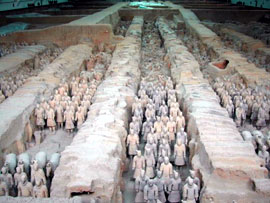|
|
|
|
Top China Destinations:
Shanghai hotels Beijing hotels Guangzhou hotels Hangzhou hotels Shenzhen hotels See more hotels in China
World Destinations:
 Guides » China » Terracotta Army Guides » China » Terracotta ArmyTerracotta Army
During the Shang and Zhou Dynasties, slaves were buried alive with their owners and aristocrats who had died. The number of slaves that had to go to an early grave depended on the number of noblemen that died and who they were.
For instance, when Duke Wu, the Ruler of the State of Qin died in 678 BC, more than 60 slaves were buried with him. However, when Duke Mu of that same state died in 621 BC, it is said that 177 slaves were sacrificed. As you can imagine, this practice caused quite a stir for the people of Qin State. Therefore, in 384 when Duke Xian took throne, it was banned. However, since slaves were still thought of as chattels, which meant slave owners began using figurines as funerary objects rather than live slaves. Then in 246 BC, Qin Shi Huang took the throne at the ripe old age of 13.  He would one-day become China’s first emperor but first, he had to start work on his mausoleum, which took 11 years to complete. Historians believe he buried a number of sacrificial objects and treasures to be with him in his after life. However, in 1974, peasants were digging for a well near the royal tomb when they made the greatest discovery in history. In addition to the various objects in the mausoleum, they uncovered a massive pit measuring more than 10 square miles. This pit was divided into three sections, which have now become known as Pit 1, Pit 2, and Pit 3. He would one-day become China’s first emperor but first, he had to start work on his mausoleum, which took 11 years to complete. Historians believe he buried a number of sacrificial objects and treasures to be with him in his after life. However, in 1974, peasants were digging for a well near the royal tomb when they made the greatest discovery in history. In addition to the various objects in the mausoleum, they uncovered a massive pit measuring more than 10 square miles. This pit was divided into three sections, which have now become known as Pit 1, Pit 2, and Pit 3.
In 1975, the State Council authorized the building of a museum, which now people from around the world can come to see and enjoy. As you look into Pit 1, which is the largest of the three, you will find columns of terracotta soldiers toward the front and then toward the back, chariots. This particular pit opened in 1979, which is one of the most mesmerizing sights imaginable. Pit 2 was not discovered until 1976 but inside, there are more than 1,000 warriors and 90 chariots made from wood. First opened in 1994, this too is an incredible sight. Then there is Pit 3, which was also discovered in 1976. The contents of this pit include 68 warriors, a war chariot, and four horses. Experts believe this pit to have been the armed forces command center. In all, the terracotta army consists of 7,000 pottery soldiers, chariots, horses, and many different weapons. Through hard work and effort, most have been beautifully restored. One of the aspects of the terracotta army that is so unique is that each of the soldiers and warriors have realistic expressions. In addition, all of the pieces found are life size. The big question remains, why. Some people believe that with an inadequate army, Qin Shi Huang created his army so that as the enemy approached, they would believe the armed forces to be much larger than they were, thus retreating. While no one is for sure, we do know that of all the things that you can experience in China or any place in the world for that matter, the terracotta army is the most sensational. Last Updated: 10/19/2006 3:14:00 PM Mode articles for China China is a world of its own, a beautiful blend of contemporary shops to incredible grasslands to the inner sanctums that include ruins, temples, caves, peaks, and many wonderful historical sites. China is a magnificent
China is a world of its own, a beautiful blend of contemporary shops to incredible grasslands to the inner sanctums that include ruins, temples, caves, peaks, and many wonderful historical sites. China is a magnificent ... continue >>  Tibet, also known as Xizang, is called the Roof of the World. This land is breathtakingly beautiful, a perfect blend of green grasslands and snow-capped mountains. The atmosphere of Tibet is truly overwhelming
Tibet, also known as Xizang, is called the Roof of the World. This land is breathtakingly beautiful, a perfect blend of green grasslands and snow-capped mountains. The atmosphere of Tibet is truly overwhelming ... continue >>  One of the greatest wonders of the world is the Great Wall of China. In fact, this structure is so magnificent that it was enlisted in the World Heritage by UNESCO in 1987. You will notice the winding up and down
One of the greatest wonders of the world is the Great Wall of China. In fact, this structure is so magnificent that it was enlisted in the World Heritage by UNESCO in 1987. You will notice the winding up and down ... continue >> |
|
| | |
|
©2025 HotelsRu.com About us Privacy Site map The Fascinating World of China |
|
 Look for deals on hotels?
Look for deals on hotels?